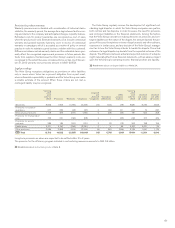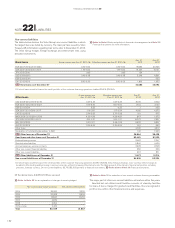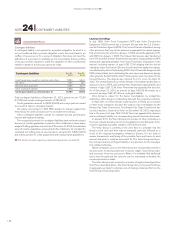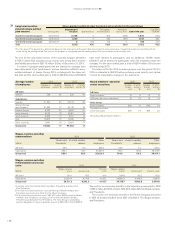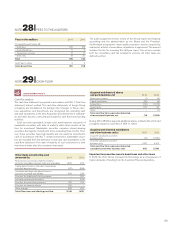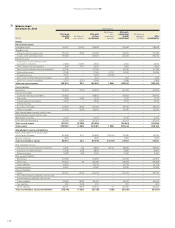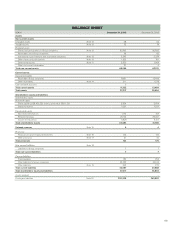Volvo 2013 Annual Report Download - page 164
Download and view the complete annual report
Please find page 164 of the 2013 Volvo annual report below. You can navigate through the pages in the report by either clicking on the pages listed below, or by using the keyword search tool below to find specific information within the annual report.
Recognition of financial assets and liabilities
Purchases and sales of financial assets and liabilities are recognized on
the transaction date. A financial asset is derecognized in the balance
sheet when all significant risks and benefits linked to the asset have been
transferred to a third party.
The fair value of assets is determined based on valid market prices,
when available. If market prices are unavailable, the fair value is deter-
mined for each asset using various measurement techniques.
Refer to footnote 1 under the table “Information regarding carrying amounts
and fair values” on page 161 in this note.
Transaction expenses are included in the asset’s fair value, except in cases
in which the change in value is recognized in the income statement. The
transaction costs that arise in conjunction with the assumption of financial
liabilities are amortized over the term of the loan as a financial cost.
Financial assets at fair value through the income statement
All of the Volvo Group’s financial assets that are recognized at fair value
through the income statement are classified as held for trading. This
includes derivatives to which Volvo Group has decided not to apply hedge
accounting as well as derivatives that are not part of an evidently effective
hedge accounting policy pursuant to IAS 39. Gains and losses on these
assets are recognized in the income statement. Short-term investments
that are recognized at fair value mainly comprise interest-bearing financial
instruments and these are disclosed in Note 18. Derivatives used for hedging
interest rate exposure in the customer financing portfolio are included in
this category. Unrealized gains and losses from fluctuations in the fair
values of the financial instruments are recognized in net financial items,
since it is not practically possible to apply hedge accounting in accord-
ance with IAS 39 due to the large number of contracts that the customer
financing portfolio comprises. In applicable cases, when the requirements
for hedge accounting are considered to be fulfilled, the Volvo Group will
hereafter consider the application of hedge accounting for these kinds of
instruments. The Volvo Group intends to hold these derivatives to maturity,
which is why, over time, the market valuation will be offset as a consequence
of the interest-rate fixing on borrowing and lending for the customer-
finance operations, and thus not affect operating income or cash flow.
Financial instruments used for hedging currency risks arising from future
firm commercial cash flows are also recognized under this category. Unre-
alized and realized gains and losses are recognized in Other financial
income and expenses to be able to enhance the possibility to net all internal
flows before entering into external derivatives, except for gains and losses
from derivatives hedging currency risks of future cash flows for specific
orders. They are recognized in operating income.
Refer to note 9 regarding derivatives used for hedging interest rate exposure in
the customer financing portfolio, and derivatives used to hedge currency risks
from future firm cash flows recognized in Other financial income and expense.
Loan receivables and other receivables
Loans and receivables are non-derivative financial assets with fixed or
determinable payments that are not quoted in an active market. Accounts
receivables are recognized initially at fair value, which normally corre-
sponds to the nominal value. In the event that the payment terms exceed
one year, the receivable is recognized at the discounted present value.
After initial recognition, loans and receivables are measured at amortized
cost in accordance with the effective interest method. Gains and losses
are recognized in the income statement when the loans or receivables are
divested or impaired, as well as in pace with recognition of accrued interest.
Assessment of impairment requirement
– loan receivables and other receivables
Volvo Group performs routine controls to ensure that the carrying amount
of assets valued at amortized cost has not decreased, which would result
in recognition of an impairment loss in the income statement. Provisions
for doubtful receivables are recognized on an ongoing basis following
assessments of a possible change in the ability of customers to pay.
Impairment comprises the difference between the carrying amount and
the current value of the estimated future payment flow attributable to the
specific asset with consideration to the fair value of any collateral. Dis-
counting of future cash flow is based on the effective interest rate used
initially. Initially, the impairment requirement is evaluated for each respec-
tive asset. If, based on objective grounds, it cannot be determined that one
or more assets are subject to an impairment loss, the assets are grouped
in units based, for example, on similar credit risks to evaluate the impair-
ment loss requirement collectively. Individually impaired assets or assets
impaired during previous periods are not included when grouping assets
for collective assessment. If the conditions that gave rise to the recogni-
tion of an impairment loss later prove to no longer be valid the impairment
loss is reversed in the income statement as long as the carrying amount
does not exceed the amortized cost at the time of the reversal.
Refer to note 15 and 16 for more information regarding Volvo Group’s loan
receivables and accounts receivables.
Assets available for sale
This category includes assets available for sale and assets that have not
been classified in any of the other category. These assets are initially
measured at fair value including transaction costs. Any change in value is
recognized directly in other comprehensive income. The cumulative gain
or loss recognized in other comprehensive income is reversed in the
income statement on the sale of the asset. Unrealized declines in value
are recognized in other comprehensive income, unless the decline is
significant or prolonged. Then the impairment is recognized in the income
statement. If the event that caused the impairment no longer exists,
impairment can be reversed in the income statement if it does not involve
an equity instrument.
Earned or paid interest attributable to these assets is recognized in the
income statement as part of net financial items in accordance with the
effective interest method. Dividends received attributable to these assets
are recognized in the income statement as Income from other investments.
Volvo Group recognizes shares and participations in listed companies
at market value on the balance-sheet date, with the exception of invest-
ments classified as associated companies and joint ventures. Holdings in
unlisted companies for which a market value is unavailable are recognized
at acquisition cost. Volvo Group classifies these types of investments as
assets available for sale.
Assessment of impairment – assets available for sale
If assets available for sale are impaired, the impaired amount is the differ-
ence between the asset’s cost (adjusted for any accrued interest if appli-
cable) and its fair value. However, if equity instruments, such as shares,
are involved, a completed impairment is not reversed in the income state-
ment. On the other hand, impairments performed on debt instruments
(interest-bearing instruments) are wholly or partly reversible in the income
statement, in those instances where an event, proven to have occurred
after the impairment was performed, is identified and impacts the valuation
of that asset.
Refer to note 5 for Volvo Group’s holdings of shares and participations in
listed companies.
ACCOUNTING POLICY
NOTE 30 FINANCIAL INSTRUMENTS
160
FINANCIAL INFORMATION 2013



